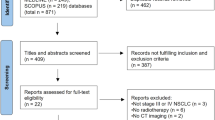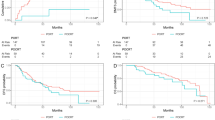Abstract
Objective
To analyze the treatment results of primary nasopharyngeal carcinoma (NPC) treated in our institution in the beginning of the 21st century to identify key failures and late effects for refining future treatments.
Methods
1093 patients with primary NPC treated during December 2001 and June 2003 were retrospectively analyzed. The distribution according to the AJCC/UICC (2002 edition) staging system was stage I in 5.8%, stage II 40.2%, stage III 32.7% and stage IVa-b 21.3%. Four different ERT techniques were used: fluoroscopy simulation conventional radiotherapy (CR) in 74.3% of patients, computer tomography simulation conventional radiotherapy (CT-sim CR) 14.2%, three-dimensional conformal radiotherapy (3D-CRT) 6.3%, intensity modulated radiotherapy (IMRT) 5.2%. In the whole series, 46.7% of patients had additional treatment with chemotherapy.
Results
The 4-year local failure-free rate (LFFR), nodal failure-free rate, distant metastasis-free rate, progression-free survival and overall survival (OS) was 89.6%, 96.1%, 85.9%, 73.0% and 82.4%, respectively. The stage was the most important prognostic factor. The 4-year OS and LFFR of patients treated by CR, CT-sim CR, 3D-CRT and IMRT was 80.2%, 89.8%, 89.8%, 92.4% and 87.7%, 96.4%, 91.0%, 96.5%, respectively. The morbidity and degree of xerostomia and trismus were lower in the patients treated by 3D-CRT and IMRT than by CR and CT-sim CR.
Conclusion
Treatment results of primary NPC in our institution have been substantially improved. Distant metastasis is the main failure. The CT simulation and conformal radiotherapy can enhance the OS and LFFR, and conformal radiotherapy can reduce the morbidity and degree of late effects.
Similar content being viewed by others
References
Lee AW, Poon YF, Foo W, et al. Retrospective analysis of 5037 patients with nasopharyngeal carcinoma treated during 1976–1985: overall survival and patterns of failure. Int J Radiat Oncol Biol Phys, 1992, 23: 261–270.
Zhang EP, Lian PG, Cai KL, et al. Radiation therapy of nasopharyngeal cancer: prognostic factors based on a 10-year follow-up of 1302 patients. Int J Radiat Oncol Biol Phys, 1989, 16: 301–305.
Geara FB, Sanguineti G, Tucker SL, et al. Carcinoma of the nasopharynx treated by radiotherapy alone: determinants of distant metastasis and survival. Radiother Oncol, 1997, 43: 53–61.
Luo W, Zhang EP, Qian JY, et al. A clinical trial in improving external irradiation technique for nasopharyngeal carcinoma. Chin J Cancer (Chinese), 2000, 19: 903–906.
Lee AW, Sze WM, Au JS, et al. Treatment results for nasopharyngeal carcinoma in the modern era: the Hong Kong experience. Int J Radiat Oncol Biol Phys, 2005, 61: 1107–1116.
Zhao C, Lu TX, Han F, et al. Clinical study of 139 nasopharyngeal carcinoma patients for intensity modulated therapy. Clin J Radiat Oncol (Chinese), 2006, 15: 1–6.
Lee N, Xia P, Quivey JM, et al. Intensity-modulated radiotherapy in the treatment of nasopharyngeal carcinoma: an update of the UCSF experience. Int J Radiat Oncol Biol Phys, 2002, 53: 12–22.
Luo W, Deng XW, Lu TX. Dosimetric evaluation of three-dimensional conformal and conventional treatment plans of early untreated carcinoma nasopharynx. Chinese-German J Clin Oncol, 2005, 4: 271–275.
Chau RM, Teo PM, Choi PH, et al. Three-dimensional dosimetric evaluation of a conventional radiotherapy technique for treatment of nasopharyngeal carcinoma. Radiother Oncol, 2001, 58: 143–153.
Kam MK, Chau RM, Suen J, et al. Intensity-modulated radiotherapy in nasopharyngeal carcinoma: dosimetric advantage over conventional plans and feasibility of dose escalation. Int J Radiat Oncol Biol Phys, 2003, 56: 145–157.
Xia P, Fu KK, Wong GW, et al. Comparison of treatment plans involving intensity-modulated radiotherapy for nasopharyngeal carcinoma. Int J Radiat Oncol Biol Phys, 2000, 48: 329–337.
Tang YQ, Luo Wei, He ZC, et al. Three-dimensional conformal radiotherapy for primary nasopharyngeal carcinoma and analysis of locoregional recurrence. Chin J Cancer (Chinese), 2006, 25: 330–334.
Cheng JC, Chao KS, Low D. Comparison of intensity modulated radiation therapy (IMRT) treatment techniques for nasopharyngeal carcinoma. Int J Cancer, 2001, 96: 126–131.
Kam MK, Teo PM, Chau RM, et al. Treatment of nasopharyngeal carcinoma with intensity-modulated radiotherapy: the Hong Kong experience. Int J Radiat Oncol Biol Phys, 2004, 60: 1440–1450.
Luo W, Lu TX. Three-dimensional conformal radiation therapy for nasopharyngeal carcinoma. Bull Chin (Chinese), 2002, 11: 281–283.
Cox JD, Stetz J, Pajak TF. Toxicity criteria of the Radiation Therapy Oncology Group (RTOG) and the European Organization for Research and Treatment of Cancer (EORTC). Int J Radiat Oncol Biol Phys, 1995, 31: 1341–1346.
Zhang EP, Luo W, Qian JY. Recommendation of a new guideline of external beam radiotherapy for nasopharyngeal carcinoma. Bull Chin (Chinese), 1997, 6: 11–13.
Yi JL, Gao L, Huang XD, et al. Nasopharyngeal carcinoma treated by radical radiotherapy alone: 10-year experience of a single institution. Int J Radiat Oncol Biol Phys, 2006, 65: 161–168.
Waldron J, Tin MM, Keller A, et al. Limitation of conventional two dimensional radiation therapy planning in nasopharyngeal carcinoma. Radiother Oncol, 2003, 68: 153–161.
Sham JS, Choy D. Prognostic value of paranasopharyngeal extension of nasopharyngeal carcinoma on local control and short-term survival. Head Neck, 1991, 13: 298–310.
Yeh SA, Tang Y, Lui CC, et al. Treatment outcomes and late complications of 849 patients with nasopharyngeal carcinoma treated with radiotherapy alone. Int J Radiat Oncol Biol Phys, 2005, 62: 672–679.
Teo P, Lee WY, Yu P. The prognostic significance of parapharyngeal tumor involvement in nasopharyngeal carcinoma. Radiother Oncol, 1996, 39: 209–221.
Leibel SA, Kutcher G, Harrison LB, et al. Improved dose distributions for 3D conformal boost treatments in carcinoma of the nasopharynx. Int J Radiat Oncol Biol Phys, 1991, 20: 823–833.
Hunt MA, Zelefsky MJ, Wolden S, et al. Treatment planning and delivery of intensity-modulated radiation therapy for primary nasopharyngeal cancer. Int J Radiat Oncol Biol Phys, 2001, 49: 623–632.
Marks JE, Bedwinek JM, Lee F, et al. Dose-response analysis for nasopharyngeal carcinoma: a historical perspective. Cancer, 1982, 50: 1042–1050.
Vikram B, Mishra UB, Strong EW, et al. Patterns of failure in carcinoma of the nasopharynx: I. Failure at the primary site. Int J Radiat Oncol Biol Phys, 1985, 11: 1455–1459.
Talmi YP, Horowitz Z, Bedrin L, et al. Quality of life of nasopharyngeal carcinoma patients. Cancer, 2002, 94: 1012–1017.
Eisbruch A, Ten Haken RK, Kim HM, et al. Dose, volume, and function relationships in parotid salivary glands following conformal and intensity-modulated irradiation of head and neck cancer. Int J Radiat Oncol Biol Phys, 1999, 45: 577–587.
Sciubba JJ, Goldenberg D. Oral complications of radiotherapy. Lancet Oncol, 2006, 7: 175–183.
Baujat B, Audry H, Bourhis J, et al. Chemotherapy in locally advanced nasopharyngeal carcinoma: an individual patient data meta-analysis of eight randomized trials and 1753 patients. Int J Radiat Oncol Biol Phys, 2006, 64: 47–56.
Langendijk JA, Leemans CR, Buter J, et al. The additional value of chemotherapy to radiotherapy in locally advanced nasopharyngeal carcinoma: a meta-analysis of the published literature. J Clin Oncol, 2004, 22: 4604–4612.
Al-Sarraf M, LeBlanc M, Giri PG, et al. Chemoradiotherapy versus radiotherapy in patients with advanced nasopharyngeal cancer: Phase III randomized Intergroup study 0099. J Clin Oncol, 1998, 16: 1310–1317.
Author information
Authors and Affiliations
Corresponding author
Rights and permissions
About this article
Cite this article
Liu, X., Luo, W., Liu, M. et al. Treatment results and prognostic analysis of 1093 primary nasopharyngeal carcinoma: the experience of a single institution of Guangzhou in the beginning of the 21st century. Chin. -Ger. J. Clin. Oncol. 7, 187–195 (2008). https://doi.org/10.1007/s10330-007-0177-2
Received:
Revised:
Accepted:
Published:
Issue Date:
DOI: https://doi.org/10.1007/s10330-007-0177-2




